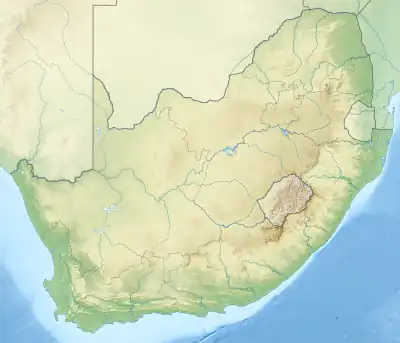 Five antennas of KAT-7 in 2014 | |
| Part of | South African Radio Astronomy Observatory |
|---|---|
| Location(s) | Northern Cape, Meerkat National Park, South Africa |
| Coordinates | 30°43′16″S 21°24′40″E / 30.721°S 21.411°E |
| Organization | Department of Science and Innovation National Research Foundation |
| Altitude | 1,100 m (3,600 ft) |
| Wavelength | 3 cm (10.0 GHz)–30 cm (1,000 MHz) |
| Built | –2011 |
| First light | 2009 |
| Telescope style | radio interferometer |
| Number of telescopes | 7 |
| Diameter | 12 m (39 ft 4 in) |
| Collecting area | 2,000 m2 (22,000 sq ft) |
| Website | www |
 Location of KAT-7 | |
| | |
KAT-7 is a radio telescope situated in the Meerkat National Park, in the Northern Cape of South Africa. Developed as the precursor engineering test bed to the larger MeerKAT telescope, previously known as Karoo Array Telescope (KAT), it has become a science instrument in its own right. The construction was completed in 2011 and commissioning in 2012. It also served as a technology demonstrator for South Africa's bid to host the Square Kilometre Array.[1] KAT-7 is the first Radio telescope to be built with a composite reflector and uses a stirling pump for 75 K cryogenic cooling. The telescope was built to test various system for the MeerKAT array, from the ROACH correlators designed and manufactured in Cape Town, now used by various telescopes internationally, to composite construction techniques.[2]
Technical specifications
KAT-7 consist of 7 dishes of 12 metres in diameter, each a prime focus reflecting telescope.[3]
| Parameter | Value |
|---|---|
| Number of antennae | 7 |
| Dish diameter | 12 m |
| Minimum baseline | 26 m |
| Maximum baseline | 185 m |
| Frequency Range | 1200...1950 MHz |
| Instantaneous Bandwidth | 256 MHz |
| Polarisation | Linear (H + V) |
| Tsys | for all elevation angles above 30°: < 35 K across the entire frequency band ~ 30 K average |
| Elevation | 2...95° |
| Mode | # Bands | Band Bandwidth | Channel Bandwidth | available? |
|---|---|---|---|---|
| Wideband | 1 | 256 MHz | 390.625 kHz | Yes |
| 8k Wideband | 1 | 256 MHz | 48.8 kHz | Yes |
| HI Spectral Line | 1 | ≥ 33.4 MHz | ≤ 4.8 kHz | ~ Oct 2012 |
| OH Spectral Line | 1 | 400/32 = 12.5 MHz | 1.5 kHz | ~ Jun 2012 |
| OH Spectral Line | 1 | 400/128 = 3.1 MHz | 0,381 kHz | ~ Jun 2012 |
Performance
In April 2010 four of the seven dishes were linked together as an integrated system to produce its first interferometric image of an astronomical object. In Dec 2010, there was a successful detection of very long baseline interferometry (VLBI) fringes between the Hartebeesthoek Radio Astronomy Observatory's 26 m dish and one of the KAT-7 dishes.[4]
See also
References
| External videos | |
|---|---|
- ↑ Campbell, Keith (2009-04-03). "An array of technology spin-offs emerges as the 'MeerKAT' radio telescope gains traction". Martin Creamer Engineering News. Retrieved 2009-06-30.
- ↑ "International Correlator Collaboration |". Retrieved 2012-05-11.
- ↑ "KAT-7". SKA South Africa Project. Retrieved 20 January 2012.
- ↑ First HartRAO-KAT-7 VLBI fringes signal new capability Archived 2012-03-11 at the Wayback Machine